Читать книгу Birds and all Nature, Vol. V, No. 5, May 1899 - Various - Страница 1
THE CEDAR WAXWING
Оглавление(Ampelis cedrorum.)
LYNDS JONES
THERE is no more beautiful bird in our northern states, if there be in the whole country, than our waxwing. Many birds are more gorgeously appareled, and with many there are more striking contrasts exhibited, but nowhere do we encounter a texture more delicate covering a bearing more courtly. One despairs of adequately describing the silky softness of the plumage and the beautiful shades of color. But the perfecting of color photography has made that task unnecessary. We may wonder why some crested birds have this regal insignia bestowed upon them by nature, but it would be impossible to think of the waxwing without his crowning glory. Not less characteristic are the horny appendages resembling red sealing wax attached to the secondary wing feathers and sometimes also to the tail feathers. They seem to be outgrowths of the tip of the shaft. These, with the yellow-tipped tail, form the only bright colors in the plumage.
The cedar waxwings are gregarious, except during the breeding-season, wandering about the country in flocks of a dozen individuals, more or less, stopping for any considerable time only where food is plentiful. Their wandering propensities make their presence a very uncertain quantity at any season of the year. During the whole of 1898 they were present in considerable numbers at Oberlin, Ohio, nesting in orchards and shade trees plentifully, but thus far in 1899 very few have been seen. No doubt their presence is not suspected even when they may be numerous, because they do not herald their appearance with a loud voice nor with whistling wing. Their voice accords perfectly with their attire, their manners are quiet and unassuming, and their flight is well-nigh noiseless. One moment the flock is vaulting through the air in short bounds, the next its members are perched in a treetop with erected crests at attention. If all is quiet without cause for suspicion, the flock begins feeding upon the insect pests, if they are in season; upon the fruit, if that is in season. So compact is the flock, both in flight and while resting, that nearly every member might be taken at a single shot. The birds are so unsuspicious that they can easily be approached, thus presenting a tempting prize to the small hunter who may design the beautiful plumage for some hat decoration.
In common with the goldfinch, the waxwings are late breeders, making their nests in June, July, and August. They seem to prefer rather small trees and low ones, nesting in orchard trees and in ornamental shrubbery as well as in shade trees. The nest is not usually an elaborate affair, but rather loosely made of twigs, grass, rootlets, and leaves, often lined with grape-vine bark, thus hinting that the species has sprung from an original tropical stock, which necessarily makes its nest as cool and airy as practicable. The eggs are unique among the smaller ones, in their steely bluish-gray ground, rather evenly overlaid with dots and scratches of dark brown or black, thus presenting an aggressiveness out of all harmony with the birds. But the peculiar colors and pattern aid greatly in rendering the eggs inconspicuous in the nest, as anyone may prove by noticing them as they lie on their bed of rootlets or leaves. They are usually four in number in this locality, but may vary somewhat according to the season and individual characteristics.
The food of the waxwing is varied both according to season and other conditions. Wild fruit, berries, and seeds form much of their food during the fall and winter months. Mr. A. W. Butler states that, "in winter nothing attracts them so much as the hack-berry (Celtis occidentalis). Some years, early in spring, they are found living upon red buds." The investigations of the food of this species by Professor F. E. L. Beal prove that the greater share of it consists of wild fruit or seeds with a very small allowance of cultivated fruits. Animal matter forms a relatively small proportion of the food, but this small proportion by no means indicates the insect-feeding habits of the birds. It might well be suspected that so varied a diet would enable the birds to accommodate themselves to almost any conditions, largely feeding upon the food which happens to be the most abundant at the time. Thus, an outbreak of any insect pest calls the waxwings in large flocks which destroy great numbers to the almost entire exclusion of fruit as a diet for the time. It cannot be denied that the waxwings do sometimes destroy not a little early fruit, calling down upon them righteous indignation; but at other times they more than make amends for the mischief done.
Of the voice Mr. A. W. Butler says, "They have a peculiar lisping note, uttered in a monotone varying in pitch. As they sit among the branches of an early Richmond cherry tree in early June, the note seems to be inhaled, and reminds me of a small boy who, when eating juicy fruit, makes a noise by inhalation in endeavoring to prevent the loss of the juice and then exclaims, 'How good!' As the birds start to fly, each repeats the note three or four times. These notes develop into a song as the summer comes on; a lisping, peculiar song that tells that the flocks are resolving into pairs as the duties of the season press upon them." After the pairing season there is a great show of affection between the two birds, which often continues long after the nesting season has closed.
